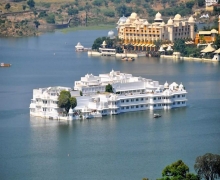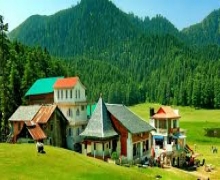3 Meteorite Crater Sites In India: Must-Visit Tourist Places

Did You Know? There Are 3 Meteorite Crater Sites In India: Must-Visit Tourist Spots
India is home to several meteorite impact crater sites, each with its own unique characteristics and scientific significance. While these sites may not be as widely recognized as some of the popular tourist destinations in India, they can be of great interest to science enthusiasts and those curious about natural wonders.
tripsgateway provides knowledgeable about various tourist places, including Solo Traveler Destinations In India, popular spots, hidden gems, and local insights.
If you are not aware, these sites offer a unique opportunity to witness the geological impact of meteorite strikes and explore their fascinating history. Do visit these meteorite impact sites!
Here Are 3 Notable Meteorite Impact Crater Sites In India:
1. Lonar Crater, Maharashtra:
The Lonar Crater, located in the Buldhana district of Maharashtra, is one of the most intriguing meteorite impact craters in India. This Solo traveler destination in India is sure to captivate you. Here are some details about the Lonar Crater:
Formation:
The Lonar Crater was formed around 50,000 years ago when a meteorite, estimated to be around 1.8 kilometers in diameter, struck the Earth's surface. The impact of the meteorite created a bowl-shaped depression, which later filled with water to form a lake.
Characteristics:
The Lonar Crater has a diameter of approximately 1.8 kilometers and a depth of about 150 meters. It is the world's third-largest meteorite impact crater formed in basalt rock. The crater is surrounded by steep walls, giving it a distinct appearance. The lake within the crater, known as Lonar Lake, is alkaline and saline, making it a unique ecosystem.
Ecological Significance:
Lonar Crater and its surrounding area have high ecological importance. The region is characterized by a mix of tropical dry deciduous forest and scrub vegetation. The lake and its vicinity support a variety of flora and fauna, including migratory birds, fish, and unique microorganisms. Lonar Lake is known for its greenish color, attributed to specific bacteria present in its waters.
Geological and Astrobiological Research:
The Lonar Crater attracts scientists and researchers from around the world due to its geological and astrobiological significance. It offers a unique opportunity to study impact cratering processes, shock metamorphism, and the effects of meteorite impacts on the geological and biological aspects of an ecosystem. The extreme conditions and high salinity of Lonar Lake make it an interesting site for studying extremophile microorganisms and their adaptations.
Cultural and Historical Importance:
Besides its scientific significance, Lonar Crater holds cultural and historical importance. The nearby Lonar town houses ancient temples, including the Daitya Sudan Temple and the Kamalja Devi Temple, which are believed to be built in the Hemadpanthi architectural style during the Chalukya dynasty. These temples attract visitors interested in both the natural and cultural heritage of the region.
Visiting Lonar Crater offers a chance to witness a unique geological phenomenon and explore the ecological diversity it supports. The combination of natural beauty, scientific interest, and historical significance makes Lonar Crater a fascinating destination for nature enthusiasts, researchers, and curious travelers alike.
Why not opt a customized Cheapest Holiday Package To Maharashtra?
2. Dhala Crater, Madhya Pradesh:
The Dhala Impact Structure, located near Shivpuri town in Madhya Pradesh, is an intriguing meteorite impact crater with its own distinctive features. Here are some details about the Dhala Impact Structure:
Formation and Age:
The exact age of the Dhala Impact Structure is uncertain, but it is estimated to be around 550 million years old. It was formed when a meteorite collided with the Earth's surface, creating a crater.
Characteristics:
The Dhala Impact Structure is a complex crater, characterized by its size and unique geological features. It has a diameter of about 12 kilometers, making it a significant impact structure. The central uplift of the crater is visible, forming a hilly topography. The rim of the crater is partially eroded and covered by vegetation, blending with the surrounding landscape.
Geological Significance:
The Dhala Impact Structure is of great interest to researchers and scientists studying impact cratering processes and their effects on geological formations. The impact event has caused significant deformation of the rocks in the area, offering insights into the high-pressure and high-temperature conditions generated by meteorite impacts.
Scientific Research:
The Dhala Impact Structure provides a unique opportunity for scientific research in the field of impact geology and mineralogy. The study of shock metamorphism and the effects of meteorite impacts on rock formations can enhance our understanding of the Earth's history and processes.
Geological History:
The presence of the Dhala Impact Structure has implications for the geological history of the region. It adds to the knowledge of the geological evolution of the area and contributes to the understanding of the larger geological context in which it exists.
Visiting the Dhala Impact Structure allows one to appreciate the geological forces at play and witness the remnants of an ancient meteorite impact event. The crater's unique features and scientific significance make it an interesting destination for geology enthusiasts, researchers, and those interested in the Earth's history.
With a customized Madhya Pradesh Holiday Package, you are sure to discover unique tourist places.
3. Ramgarh Crater, Rajasthan:
The Ramgarh Crater, located near the village of Ramgarh in Rajasthan, is an intriguing meteorite impact structure with its own distinct characteristics. Here is some information about the Ramgarh Crater:
Formation and Age:
The Ramgarh Crater was formed due to the impact of a meteorite, estimated to be around 1.7 million years old. The exact size of the meteorite that created the crater is not known, but it is believed to have been a substantial impact event.
Characteristics:
The Ramgarh Crater is a well-preserved impact structure with a diameter of approximately 3.4 kilometers. It is surrounded by a circular rim that is still visible today. The crater exhibits a raised central peak, known as the central uplift, which is a common feature in impact craters. The rocks in and around the crater are predominantly sandstone and limestone.
Geological Significance:
The Ramgarh Crater holds significant geological importance. It provides scientists and researchers with valuable insights into impact cratering processes, shock metamorphism (changes in rocks due to the impact), and the geological history of the region. By studying the Ramgarh Crater, scientists can gain a deeper understanding of the dynamics and effects of meteorite impacts on the Earth's surface.
Surrounding Landscape:
The area surrounding the Ramgarh Crater is characterized by arid desert-like conditions. The region showcases a unique blend of natural beauty and geological formations. The impact of the meteorite has resulted in the creation of distinct features in the landscape, making it an interesting site for exploration and scientific study.
Visitor Experience:
While the Ramgarh Crater is not extensively developed for tourism, it is possible to visit the site and witness the impact structure firsthand. With a customized Rajasthan Tour Packages, do plan a trip to this unique tourist spot.
Exploring the rim and the central uplift of the crater provides a glimpse into the powerful forces of nature and the fascinating geological history of the area. Visiting the Ramgarh Crater offers an opportunity to appreciate the remnants of a meteorite impact event and explore the geological wonders of the region. The crater's unique features and scientific significance make it an intriguing destination for geology enthusiasts, researchers, and those interested in the Earth's geological history.
Rajasthan is also one of the best Budget Friendly Honeymoon Destinations In India.
Meteorite Impact Crater Sites In India
These meteorite impact crater sites in India serve as important geological and scientific landmarks. They provide valuable opportunities for studying impact processes, geological evolution, and their effects on the surrounding ecosystems. They also offer insights into the history of meteorite impacts and their role in shaping the Earth's surface.
Are You Wondering What’s It’s Like To Visit Unique Places?
Why wait? Just pack your bags and embark on a journey to one of these unique tourist spots. tripsgateway tries to introduce to you places, you have never heard of or have never been before. Tripsgateway is a part of Catabtic Technology Pvt. Ltd. With us you can get ready for a destination in a more fun way! For couple do explore the Best Honeymoon Destinations In India with us.
Frequently Asked Questions
1. Best solo traveler destinations in India?
Rishikesh, Varanasi, Goa, McLeod Ganj, Jaipur, Hampi, Pushkar, Darjeeling, Auroville, Jaisalmer
2. Best honeymoon destinations in India?
Udaipur, Rajasthan; Goa; Kerala (Alleppey, Munnar, Wayanad); Andaman and Nicobar Islands; Shimla, Himachal Pradesh; Ooty, Tamil Nadu; Jaisalmer, Rajasthan; Darjeeling, West Bengal; Agra, Uttar Pradesh (Taj Mahal); Srinagar, Jammu and Kashmir (Dal Lake, Shikara rides)
3. Best family vacation destinations in India?
Goa, Shimla, Munnar, Jim Corbett National Park, Lonavala, Mahabaleshwar, Jaipur, Alleppey, Agra





